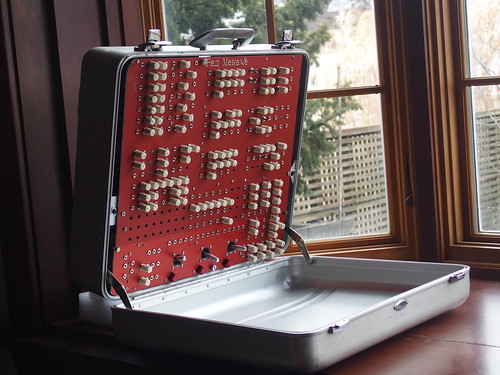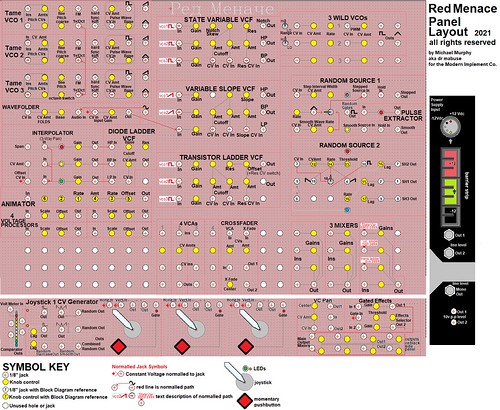The Red Menace
A decade from start to finish!
The Red Menace is a modular analog synthesizer that I built to prove that my iconoclasm was not mere provocation for provocations sake. This system is one of the few instruments I’ve built that adapts easily to being played by a 12-note/Octave keyboard.
The modular panel is separate and the system can just as easily be played without a keyboard, using knobs and the 3 Joysticks.
The project originated in 2010. It was inspired, as many of my ideas are, by the donation of an enclosure. In this case my inordinately generous mentor Grant Richter gave me a Haliburton aluminum suitcase. It was so sleek that it just begged for something much more neatly ‘tailored’ than my usual deconstructed aesthetic. Unfortunately this meant that I had to commit to a panel design in advance and this approach precluded my usual heavily improvised method. It behooves me to acknowledge Olivia Mabuse (aka Veal Hutchins) in this endeavor . She composed and took the photos here in the gray ‘Siberian’ light, and more importantly she did the lion’s share of the panel wiring on the large vertical panel. Considering the size and scale of that panel, this was no mean feat. This project paused and restarted with revisions dozens of times between 2010 & 2020 and when I had it in the home stretch in the summer of 2020 there were naturally HUNDREDS of loose ends to improve and repair. To Olivia’s credit, not one of the nearly 1000 junctions she soldered was a point of failure.
The final version was not finished until late 2020 (the COVID-19 Pandemic had to have some silver-lining, eh?) The finished version was very different from the version I conceived in 2010. I attribute this extensive evolution to the wisdom I accumulated from hundreds of public performances in large & tiny venues in the intervening decade .
Here is the panel-layout for the modular panel:
There are no legends on the panels. Only a Cyrillic phoneticization of “Red Menace” was engraved.
The vertical panel consists of a large & small panel this makes removal and access easier. The features were laid out in a way that employs symmetries that are easy for me to remember, and there are a lot of normalled paths wired underneath the hood. There are also a lot of unused holes for expansion, especially in the lower row of the large panel.
To summarize the roster of modules:
Large Upper Panel
3 ‘Tame’ VCOs with 1V/Oct, linear FM, sync & PWM
3 ‘Wild’ VCO/LFOs with PWM
Animator
Wavefolder
3-input Interpolating Crossfader
2-input Crossfader/VCA
4 VCAs
Diode Ladder VCF, LP BP HP
Transistor Ladder VCF LP with VC-Resonance
State Variable VCF with VC resonance, BP HP Notch
Variable Slope VCF, LP BP HP
2 Complex multi-output Random CV generators
3 Mixers
4 CV Processors
Small Lower Panel
3 Joystick/ Manual Gates
Complex Random CV Generator driven by Joystick #1
VC-panner
Gated Effects processor
2 Mixers
LED voltage meter
The Keyboard is a separate device with a separate power supply.
Normally I eschew keyboards. Of all the means of controlling something as flexible and fluid as an analog circuit, I can’t conceive of a controller LESS suited to the job than a keyboard. But if there is a theme to the design of the Red Menace, it’s doing all the things I don’t normally do. So I decided that that in the Red Menace Keyboard design I would go way beyond just 1/12-volt steps, trigger, & gate. I wanted to integrate all the functions that are intrinsically related to keyboard control such as, VC-ADSR envelopes with integrated VCAs & mixers, Pitch Bend, Vibrato, and just because…
…a couple of spare complex CV generators (or my name isn’t Dr. Alphonse Caspar Mabuse!)
If you’re very old you might recognize that this keyboard began life as a Rheem Kee-Bass (!) The decision to use this lurid acid-casualty from the summer of love was fraught with a tangle of pros & cons:
It’s Red. (Psychedelic Iridescent Red, no less!)
It’s only 2 octaves. (so I had to implement a hair-trigger octave switching control)
It fit EXACTLY in the bottom half of the Haliburton case.
It had a TOS USS Enterprise [NCC-1701]-style lever control already on it.
Strung above the keyboard on two acrylic struts is a thin steel ‘high wire’. This thin steel band is a kind of touch-plate. It responds to the amount of skin in electrical contact with it and translates that vector to a smooth CV that rises or falls. This CV is normalled to the keyboard CV. The choice of up or down is kind of a coin toss. I could not resist the temptations of my fetish for a bit of indeterminacy completely. I strung this band at a height above the keys that allows me to contact it with the back of my hand near the wrist. This allows me to depress a key and then wobble the pitch (or not) by rocking my hand back & forth; very similar to the motion for vibrato on a ‘cello string. This CV can be routed to any other CV vector too, of course.




Comments are closed.